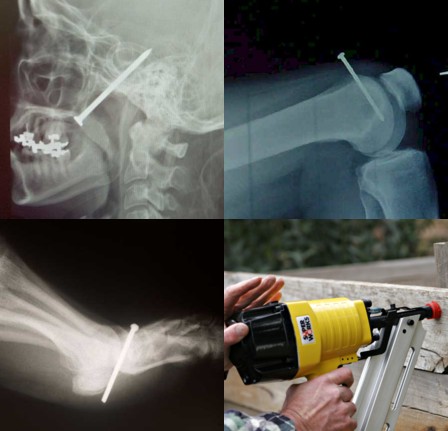Pneumatic Nail Gun Safety

Nail guns drive nails and staples into building materials. Injuries or fatalities can result from improper use. This tool is an important part of the construction and manufacturing industries but used incorrectly or haphazardly and it can become a nightmare. Give this tool the respect it deserves, be a professional and make Nail Gun Safety a priority to keep everyone safe.
Hazards
The operator and coworkers are at risk. Eyes, hands and fingers are especially at risk. Nails can:
- Splinter or blow out fragments from the material.
- Puncture the back of the material.
- Fire completely through the material and strike workers behind the nailing surface.
- Pose contact hazards, such as nails striking electrical wires.
Common Tool Types
Sequential tools: Require nose (workpiece contact) to be depressed before the trigger is pulled.
- Two-step sequence makes accidental firing less likely.
- Can be used for most nailing tasks.
Contact tools: Tool fires anytime the trigger and nose (workpiece contact) are both depressed.
- Trigger can be held down to allow “bump firing”.
- Use for nailing on flat surfaces.
Common Tool Types
If the trigger is depressed, the tool will fire anytime the nose is depressed; it can also cause unwanted double firing of nails.
Safe Work Practices and PPE
- Follow manufacturer’s tool labels and operating manual.
- Wear safety glasses with side shields.
- Never defeat or modify safety features.
- Keep fingers away from trigger when not driving nails.
- Sequential tools have reduced risk of accidental and double firing.
- Avoid line of fire hazards in front of and behind material; position yourself (especially your free hand) out of the line of fire. Never point nail gun at anyone. Watch for coworkers behind the nailing surface.
- Disconnect the gun to perform maintenance, move to another work area, or clear jams.
- Train on safe operating procedures, proper body placement and correct PPE use.
NOTE: The tool must meet applicable OSHA guarding standards.